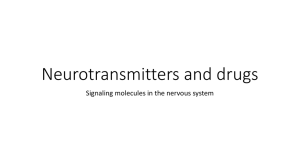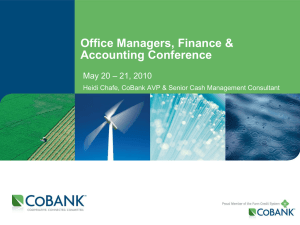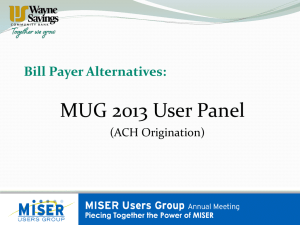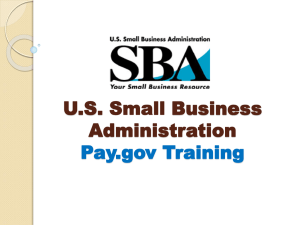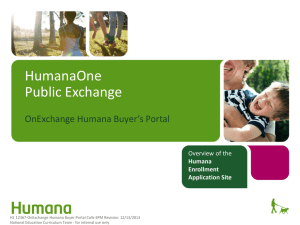Payments 2013 Conference April 23, 2013 in San Diego, CA
advertisement
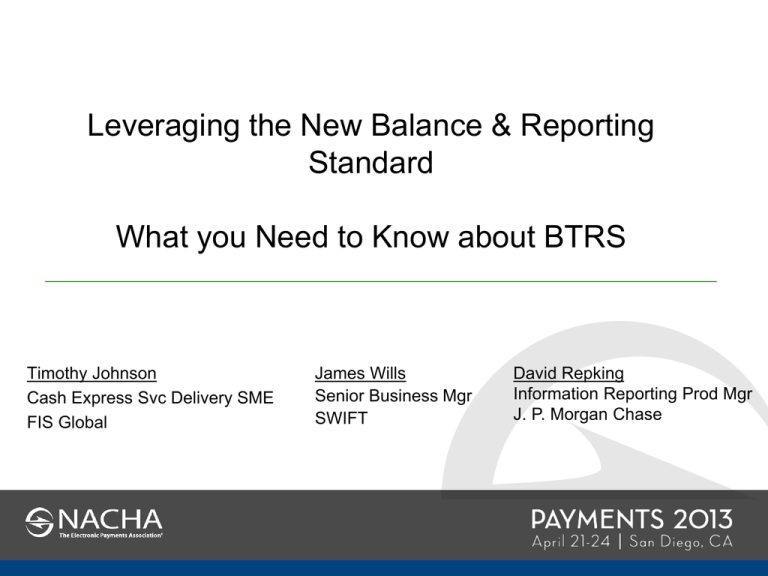
Leveraging the New Balance & Reporting Standard What you Need to Know about BTRS Timothy Johnson Cash Express Svc Delivery SME FIS Global James Wills Senior Business Mgr SWIFT David Repking Information Reporting Prod Mgr J. P. Morgan Chase 2 Welcome to PAYMENTS 2013 PAYMENTS 2013 Mobile App: Check-in on the mobile app. Download: ddut.ch/PAYMENTS WiFi: Complimentary Internet access is available via the PAYMENTS2013 network, password: WesternUnion CECs: Most sessions count toward continuing AAP accreditation. Learn more about becoming an AAP at the NACHA and RPA booth in the exhibit hall. PAYMENTS 2014: Register today to receive PAYMENTS 2013 early-bird rates for PAYMENTS 2014. Visit the registration desk for more details. Join the Conversation on Twitter: @NACHA_PAYMENTS #PAYMENTS2013 3 Thank you to our Sponsors Objectives From this session you will learn: 1. A Vendor’s Perspective of BAI2 Challenges 2. How BTRS was Formulated 3. Key Elements of the new BTRS Standard 4. The BTRS Implementation Process for Banks and Companies 5. Various Tools Available from the X9 Organization 4 5 Data Interchange History and Challenges Chronology • 1965: Holland-America Steamship Line used telex messages to transmit shipping manifest that were then converted for use as computer input. Considered the first EDI (Electronic Data Interchange) † • 1973: FTP Protocol Published † • 1975: Treasury Management Services – Balance Reporting (BALDIS format) Multi Bank Reporting processing. • 1980: BAI1 – Bank Administration Institute publishes the Cash Management Balance Reporting Specification , Version 1 †‡ • 1987: BAI2 is published †‡ • 2001: BAI2 final official update. Shortly after this release the standard is considered self-sustaining and is no longer actively supported or updated. † • 2008: Bank Administration Institute transfers copyright ownership of the BAI format to Accredited Standards Committee x9, Inc. BAI established as an American National Standard. † † source: Wikipedia (http://en.wikipedia.org/wiki/BAI_(file_format) ‡ source: BAI (http://www.bai.org/about-bai/reporting-codes.aspx) 6 Data Interchange History and Challenges A vendor’s perspective of Multi-bank Reporting • Multi-bank defined • The wild, wild west of Information Reporting – 900 series Custom Type Codes – Mixed formats – Proprietary formats – Inaccuracy of Data BTRS addresses all these issues 7 Balance and Transaction Reporting Standard (BTRS) History 1. BAI2 Copyright Transferred to Accredited Standards Committee X9, Inc. in 2008 2. AFP Survey Administered in April 2010 by David Bellinger 3. Responses from 1,116 Corporates concluded: a) Payments industry has evolved to the point where BAI2 is no longer effective b) Customization has resulted in large disparities between banks – – – c) Inconsistent formats, syntax and transaction codes Too many similar BAI codes Too many unused codes Very difficult to automate the data importation to internal systems 4. BTRS Formulated & Approved by ANSI (2010 – 2012) 5. BTRS Now Replaces BAI2 as the Industry Standard 6. ASC X9 to announce future sunset date for BAI2 8 X9 Workgroups The Accredited Standards Committee X9 has the mission to develop, establish, maintain, and promote standards for the Financial Services Industry. X9 BAI2 Standards Lead Jim Wills, SWIFT BAI Codes Update Chair David Repking, J.P. Morgan Co-Chair Greg Malosh, Bank of NY Mellon Language of the Standard Chair John Scully, Bank of America Co-chair Bill Lundeen , Proctor and Gamble Wire Remittance Structure Chair Gina Russo, Federal Reserve Bank Co-Chair Susan Colles, Bank of America 9 The New BTRS A Foundational Release The Balance and Transaction Reporting Standard (BTRS) is intended to increase standardization of and improve upon BAI2 Changes include: 1. User Guide Modernized to include developments in banking and technology over the past 25 years 2. Rationalization and Reduction of the number of supported transaction codes 3. Globalization: – Additional SEPA transaction codes to support new European payment types – Double byte character set support through the incorporation of UTF-8 – SWIFT and ISO 20022 XML interoperability – Code Mapping and Balance Inclusions – Modified currency rules to make them mandatory and allow for multi-currency 4. New batch level (89) and invoice level (90) records providing additional information using ISO 20022 component tags to assist in reconciliation and straight through processing 5. Additional structure to 88 record to support extended wire remittance in CTP payments 10 The New BTRS Highlights Goal: BTRS is as backward-compatible to BAI2 as possible! 1. What does NOT change – – – Syntax No new positional fields 88, 49, 98, 99 Records (Hash totals) 2. File Header Record (01) – 1 = BAI1, 2 = BAI2, and 3 = BTRS 3. Account Record (03) – – – Modernized the list of Status and Summary Codes Core Balance fields and the Currency Code field are now required Inclusion of total credits and total debits are now required 4. Detail Record (16) – – – – Modernized the list of Detail Transaction Codes Eliminated Funds Type “D” (Distributed Availability) – use Funds Type “S” Created New Batch 89 and Invoice 90 Record Types Instituted a new Standard format for Wire Remittance CTP (aligned with ISO field names) 11 The New BTRS Status & Summary Codes Status Codes 1. 28 Codes Deleted 2. Opening Available (035) = Balance on the date reported 3. CD & PD Required Balances 4. ISO & SWIFT Interoperability Summary Codes Type Status Code Descriptions Code 010 Opening Ledger 015 Closing Ledger 020 Average Closing Ledger MTD 025 Average Closing Ledger YTD 030 Current Ledger 035 Opening Available 040 045 050 055 057 060 1. 92 Codes Deleted 2. 1 Summary Code per Detail 3. Record 03, always include – 100 Total CR & 400 Total DR 4. Globalization – “Float” to “Available” Opening Available Next Business Day Closing Available Average Closing Available MTD Average Closing Available YTD Investment Sweep Position Current Available ISO Family ISO Sub-Family SWIFT OPBD CLBD OpeningBooked ClosingBooked Current Day :60F: :62F: ITBD OPAV InterimBooked :62M: OpeningAvailable :65: FWAV ForwardAvailable :65: CLAV ClosingAvailable :64: ITAV InterimAvailable :65: Prior Day YES YES Yes YES YES 12 The New BTRS ACH Detail Codes Type Code Comparison of BAI2 vs BTRS ACH Codes 141 142 143 145 164 165 166 168 Green = BTRS Red = Obsolete 169 257 441 445 447 451 455 464 466 468 469 557 BAI2 Description ACH Credit Received Item in ACH Deposit ACH Concentration Credit Corporate Trade Payment Credit Preauthorized ACH Credit ACH Settlement ACH Return Item or Adjustment Settlement Miscellaneous ACH Credit Individual ACH Return Item ACH Concentration Debit ACH Disbursement Funding Debit ACH Debit Received Preauthorized ACH Debit Corporate Trade Payment Debit ACH Settlement ACH Return Item or Adjustment Settlement Miscellaneous ACH Debit Individual ACH Return Item BTRS ACH SEPA Transfer use 165 use new 89/90 records use 165/166 use 165/166 ACH Received ACH Originated Settlement ACH Originated Settlement Return ACH Miscellaneous ACH Received - Return ACH SEPA Transfer use 455/466 use 466 use 455 ACH Received use 455/466 ACH Originated Settlement ACH Originated Settlement Return ACH Miscellaneous ACH Received - Return 13 The New BTRS ACH Detail Codes 110 Codes Deleted Normalization Globalization – – Added SEPA Codes Local Language (UTF8 – e.g., Chinese) Type CR DB CR DB CR DB CR DB CR DB CR DR Detail Code 169 469 166 466 168 468 165 455 257 557 141 441 Summary Code 140 450 167 450 167 467 140 450 256 450 140 450 – – – Full, Clear set of codes 1 Summary Code Assigned to each Detail Code (1:1) Interoperability between BTRS, ISO & SWIFT Description ACH Miscellaneous ACH Miscellaneous ACH Originated Settlement ACH Originated Settlement ACH Originated Settlement - Return ACH Originated Settlement - Return ACH Received ACH Received ACH Received - Return ACH Received - Return ACH SEPA Transfer ACH SEPA Transfer ISO Domain PMNT PMNT PMNT PMNT PMNT PMNT PMNT PMNT PMNT PMNT PMNT PMNT ISO Family RCDT ICDT RCDT ICDT ICDT RCDT RCDT ICDT ICDT RCDT ICDT ICDT ISO SubFamily ATXN ATXN ASET ASET ARET ARET ACDT ADBT ARET ARET ESCT ESDD SWIFT DDT DDT STO STO RTI RTI DDT DDT RTI RTI STO STO 14 The New BTRS What if I need a new Code? By instituting BTRS under “Continuous Maintenance”, changes are readily adopted. Step 1: Request the new code via X9 Website. Step 2: If urgently required, use 900 series codes until X9 assigns a new code. The New BTRS New Batch and Invoice Reporting Record Codes Requirement: Indicate the items within a batch with associated invoices Challenge: Double-reporting! Solution: Insert items as a continuation of Transaction Detail – 89 Batch Detail – 90 Invoice Detail 15 The New BTRS New Batch and Invoice Reporting Record Codes Batch Record 89 Allows you to insert information about the items within a batch. Your Bank will need to include the 89 Record in your BTRS file and you will need to parse & load them Example: A Credit Settlement of $200 Represents 2 Originated Batches Valued at $100 each 16,166,20000,S,20000,0,0,RRRRRRRRRR,9999999999/ 88,ORIG CO NAME=YYYYYYYYYYYYYYYY,ORIG ID=5555555555,ENTRY DESCR=RTN OFFSET,ENTR 88,Y CLASS=CCD,TRACE NO=021000024641577,ENTRY DATE=110919,IND ID NO=1234567890, 88,IND NAME=NNNNNNNNNNNNNNNNNN,REMARK=EFT ITEMS OFFSET FOR FILE DATE MM/DD/YY 89,<CdtDbInd> CR <Ref> RRRRRRRRRR <Dt> YYMMDD <Amt> 100.00 <OrigNm> AAAAAAAAAAAA 88,<OrigId> AAAAAAAAAAA <AddtlNtryInf> DDDDDDDDDDDD <ActlDt> YYMMDD <BatNb> BBB1 88,BBBBBB <Nb> NNNNNNNNNNNN <Nm> MMMMMMMMMMMMMMMMMM <AddtlTxInf> XXXXXXXXX 89,<CdtDbInd> CR <Ref> RRRRRRRRRR <Dt> YYMMDD <Amt> 100.00 <OrigNm> AAAAAAAAAAAA 88,<OrigId> AAAAAAAAAAA <AddtlNtryInf> EEEEEEEEEEEE <ActlDt> YYMMDD <BatNb> BBB2 88,BBBBBB <Nb> NNNNNNNNNNNN <Nm> MMMMMMMMMMMMMMMMMM <AddtlTxInf> XXXXXXXXX 16 17 Implementing the New Standard A vendor’s perspective of Multi-bank Reporting A Phased BTRS Implementation Approach 1. Conversion of BAI1 and/or BAI2 to BTRS for Balance Reporting to Corporate Customers (outbound) 2. Conversion of BAI1 and/or BAI2 to BTRS for large scale FI Processing 3. SWIFT MT conversion to BTRS 4. Receipt and Processing of BTRS formatted files (inbound) 5. BTRS for Corporate Customers and FI utilizing XML file structures and format (inbound and outbound) 18 The New BTRS Simplifying the Implementation Process Moving to the BTRS Standard is a coordinated effort by both Banks and Companies 1. Banks should: – – – – Begin to offer the BTRS format within 12-18 months Remap deleted Detail Codes using the Technical Implementation Guide Remap Summary Codes to the standard associated to each Detail Code Provide only codes on the list (Request New codes via X9) 2. You should: – – – – Visit the X9 Website to get your FREE copy of BTRS and to learn more Determine the impact to you back-office system for the new BTRS Format Ask your banks for their plans to upgrade from BAI2 to BTRS Tell your banks YOUR requirements for upgrading (Remember, you asked for these BTRS improvements!) 19 Resources 20 Resources X9 BTRS Website http://www.x9.org/home/ 21 Resources BTRS is the New Face of BAI2 22 Questions 23 Interested in attending a Webinar? Represent your Company on X9 BTRS Committees? Give your Business Card to or email Tom, Jim or Dave Tim Johnson, FIS Global Tim.N.Johnson@fisglobal.com Jim Wills, SWIFT james.wills@swift.com David Repking, J.P. Morgan Chase david.repking@jpmchase.com


